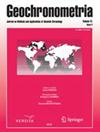用低速旋转剪切仪测定断裂对ESR强度的影响
IF 0.9
4区 地球科学
Q3 Earth and Planetary Sciences
引用次数: 2
摘要
摘要我们使用低速旋转剪切装置剪切模拟石英泥,并在考虑污染物问题的情况下定量评估了电子自旋共振(ESR)强度与位移之间的关系。随着位移的增加,E1’中心的ESR强度增加,OHC和过氧中心的ESR强度保持不变。显微结构分析表明,起始凿泥的晶粒尺寸减小并断裂;因此,断裂会影响ESR强度的变化。还对具有不同污染物量的起始凿泥进行了ESR测量,并证实污染物对ESR强度变化的影响可以忽略不计。此外,我们估计了表面和颗粒之间摩擦加热引起的温度升高,结果表明,在我们的实验条件下,摩擦加热对ESR强度的影响也可以忽略不计。因此,我们可以从污染物和摩擦加热中分别阐明ESR强度与不同位移的压裂之间的关系。结果表明,浅层摩擦加热较低的断裂不会导致ESR信号的归零。本文章由计算机程序翻译,如有差异,请以英文原文为准。
Effect of Fracture on ESR Intensity Using a Low-Velocity Rotary Shear Apparatus
Abstract We sheared simulated-quartz gouges using a low-velocity rotary shear apparatus and evaluated the relationship between electron spin resonance (ESR) intensity and displacement quantitatively considering problems of contaminants. ESR intensity of E1’ centre increased while OHC and peroxy centre kept constant with the increasing displacement up to 1.4 m. Microstructural analysis showed grain size reduction and fracture of starting gouges; hence, the fracture can affect the change in ESR intensity. ESR measurements were also conducted for starting gouges with variable amounts of contaminants, and it was confirmed that the effect of contaminants on the change in ESR intensity was negligible. Moreover, we estimated the temperature rise by the frictional heating on the surface and between particles, and it was shown that the effect of frictional heating on ESR intensity was also negligible in our experimental condition. Therefore, we could clarify the relationship between ESR intensity and fracturing with various displacements separately from contaminants and frictional heating. The results imply that the zero-setting of ESR signals cannot occur by the fracture with low frictional heating at the shallow depth.
求助全文
通过发布文献求助,成功后即可免费获取论文全文。
去求助
来源期刊

Geochronometria
地学-地球科学综合
CiteScore
2.20
自引率
0.00%
发文量
1
审稿时长
>12 weeks
期刊介绍:
Geochronometria is aimed at integrating scientists developing different methods of absolute chronology and using them in different fields of earth and other natural sciences and archaeology. The methods in use are e.g. radiocarbon, stable isotopes, isotopes of natural decay series, optically stimulated luminescence, thermoluminescence, EPR/ESR, dendrochronology, varve chronology. The journal publishes papers that are devoted to developing the dating methods as well as studies concentrating on their applications in geology, palaeoclimatology, palaeobiology, palaeohydrology, geocgraphy and archaeology etc.
 求助内容:
求助内容: 应助结果提醒方式:
应助结果提醒方式:


